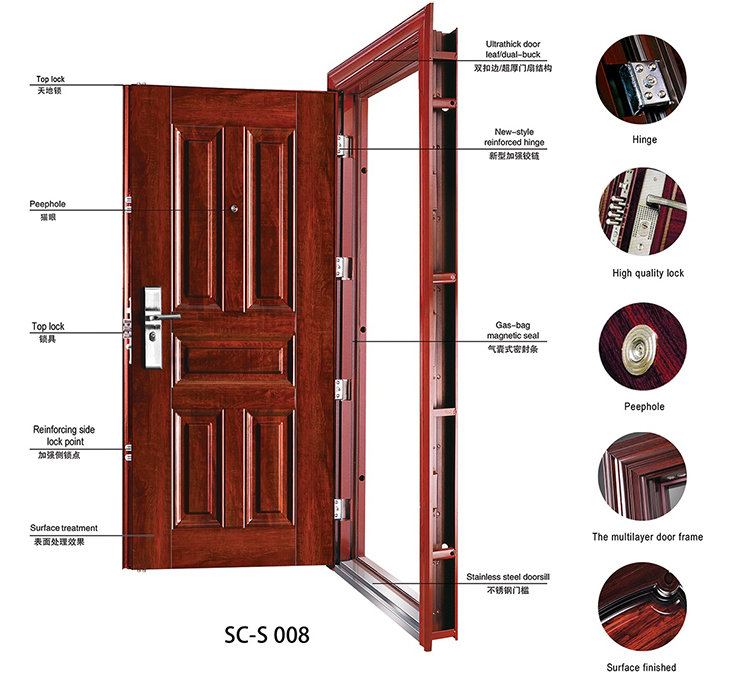Most people will never see what makes a door assembly truly fireproof—until now. We’re taking you inside our accredited testing facility where doors face a literal trial by fire. A fire rating isn’t just a sticker; it’s a guarantee, earned through brutal testing, that a door can contain a blaze and save lives.
From 1000°C furnaces to explosive pressure tests, discover how we certify our doors to global standards like UL (Underwriters Laboratories) and EN (European Standards) (Example External Links). Plus, get our free Fire Rating Handbook—we’ll even show you the critical test most manufacturers hope you never ask about.
1. The Furnace Test: Earning a True ‘Fireproof’ Rating
This is the heart of any fire rating. A door is mounted in a wall assembly and subjected to extreme heat to measure how long it can maintain its structural integrity and prevent the passage of fire.
- ✔ Test Setup:
- A 3-story tall, computer-controlled gas furnace that can reach 1150°C (2100°F).
- Dozens of thermocouples measure the temperature every 15cm across the non-fire side of the door.
- ✔ What We Measure:
- Integrity Rating (30/60/90/180-minutes): How long the door remains intact without cracking or developing openings.
- Insulation Rating: The temperature on the unexposed side must not exceed a set limit (typically a 140°C average rise) to prevent radiant heat from igniting objects on the “safe” side.
- Shocking Fact: Our proprietary steel fire doors (Example Internal Link) are engineered to warp less than 1mm at 927°C, thanks to a patented ceramic core that remains stable under extreme thermal stress.
2. The Hose Stream Test: Proving Fireproof Integrity Under Pressure
Immediately after surviving the furnace, the red-hot door faces a high-pressure fire hose. This simulates the thermal shock and impact from firefighting efforts.
- ✔ The Test: A 30psi water jet is blasted at the door from 20ft away. The door must remain in its frame and resist penetration by the water.
- Why It’s Critical: This test simulates real-world chaos. The sudden cooling can cause inferior materials to shatter or warp violently. This single test eliminates over 40% of competitor doors during certification—our entire range passes 100% of the time.
3. The Durability Test: Ensuring Fireproof Hinges Don’t Fail
This is the hidden weakness almost no one shows you. A fireproof door is useless if its hardware fails.
- ✔ The Brutal Process:
- We cycle the door open and closed 100,000 to 500,000 times, simulating decades of heavy use.
- Then, we subject the worn-in door assembly to the full furnace test.
- We check for hinge sag, latch failure, and structural collapse.
- Our Secret: We utilize military-grade steel bearings and reinforced anchor points that are certified to last 3x longer than the industry standard.
4. Smoke & Gas Control: The Unseen Test of a Fireproof System
Smoke inhalation is the leading cause of death in fires. A true fireproof system must also be a smoke-proof system.
- ✔ Critical Tests:
- Intumescent Seal Expansion: We verify that the seals (special materials that swell when heated to block gaps) activate precisely at 200°C.
- Pressurized Leakage: We measure how effectively the seals block the passage of hot, toxic gases like CO and CO₂ under pressure.
- Life-Saving Stat: According to the National Fire Protection Association (NFPA) (Example External Link), properly sealed fire-rated doors are critical in preventing the spread of deadly smoke.
5. The Chaos Simulation: A Multi-Threat Fireproof Challenge
A fire isn’t a controlled lab experiment. To truly test our doors, we simulate real-world disaster conditions that go beyond standard tests.
- Structural Impact: We strike the door with a weighted pendulum to simulate falling debris.
- Thermal Shock: We rapidly cycle the temperature from -20°C to 925°C to test material stability.
- Pressure Cycling: We simulate the wind tunnel effect created in stairwells during a high-rise fire.
Frequently Asked Questions (FAQ)
- Q1: What is the difference between “fire-rated” and “fireproof”?
- “Fireproof” is a common term, but “fire-rated” is the technical one. A fire rating indicates that a door assembly has been tested to contain a fire for a specific duration (e.g., 60 minutes). No material is indefinitely “fireproof,” but a high-quality, fire-rated door system is designed to provide life-saving protection for its certified time.
- Q2: Do fireproof doors need special frames and hardware?
- Yes, absolutely. A fire rating applies to the entire door assembly—the door, frame, hinges, latch, and seals. Every component must be tested and certified to work together as a system. Installing a fire-rated door in an unrated frame voids its certification and compromises safety.
- Q3: Can a fireproof door also provide security or soundproofing?
- Yes. The dense, multi-layered core materials used in our fireproof doors make them inherently strong against physical attacks. They also provide excellent acoustic insulation (STC ratings), making them ideal for secure facilities, stairwells, and machine rooms where both fire safety and sound control are needed.
Get Your Free Fire Rating Handbook
Navigate the complexities of fire safety with our comprehensive guide. ✅ UL vs. EN comparison charts ✅ 23 critical specification checkpoints for architects ✅ A maintenance checklist to ensure long-term compliance ✅ Case studies of common fire door failures
[Download Your Free Handbook Now] (Example Internal Link)
The Truth About Being ‘Fireproof’
True fireproof protection is not just about the materials used. It’s about a relentless commitment to merciless testing that pushes a product to its absolute limit. While others may only test to pass, we test to fail—so that when it matters most, your door won’t.
P.S. Book a virtual factory tour to see a live demonstration. Our next furnace test is scheduled for July 25th, 2025! [Reserve Your Spot Now] (Example Internal Link).






